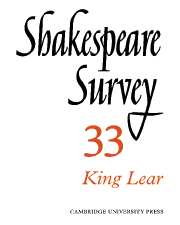Book contents
- Frontmatter
- King Lear: A Retrospect, 1939–79
- Some Conjectures on the Composition of King Lear
- The War in King Lear
- King Lear: Art Upside-Down
- ‘And that’s true too’: King Lear and the Tension of Uncertainty
- The Taming of the Shrew and King Lear: A Structural Comparison
- Medium and Message in As You Like It and King Lear
- Playing King Lear: Donald Sinden talks to J. W. R. Meadowcroft
- Hamlet’s Special Providence
- Antony and Cleopatra: ‘The Time of Universal Peace’
- Patterns of Motion in Antony and Cleopatra
- Theme and Structure in The Winter’s Tale
- Peter Street at the Fortune and the Globe
- English Actors at the Courts of Wolfenbüttel, Brussels and Graz during the Lifetime of Shakespeare
- Shakespeare at Stratford and the National Theatre, 1979
- The Year's Contributions to Shakespearian Study 1 Critical Studies
- 2 Shakespeare’s Life, Times, and Stage
- 3 Textual Studies
- Index
- Plate Section
The War in King Lear
Published online by Cambridge University Press: 28 March 2007
- Frontmatter
- King Lear: A Retrospect, 1939–79
- Some Conjectures on the Composition of King Lear
- The War in King Lear
- King Lear: Art Upside-Down
- ‘And that’s true too’: King Lear and the Tension of Uncertainty
- The Taming of the Shrew and King Lear: A Structural Comparison
- Medium and Message in As You Like It and King Lear
- Playing King Lear: Donald Sinden talks to J. W. R. Meadowcroft
- Hamlet’s Special Providence
- Antony and Cleopatra: ‘The Time of Universal Peace’
- Patterns of Motion in Antony and Cleopatra
- Theme and Structure in The Winter’s Tale
- Peter Street at the Fortune and the Globe
- English Actors at the Courts of Wolfenbüttel, Brussels and Graz during the Lifetime of Shakespeare
- Shakespeare at Stratford and the National Theatre, 1979
- The Year's Contributions to Shakespearian Study 1 Critical Studies
- 2 Shakespeare’s Life, Times, and Stage
- 3 Textual Studies
- Index
- Plate Section
Summary
The battle in act V between Cordelia’s army and the combined armies of Albany and Edmund must rank among the most important events in King Lear. Structurally, we have been led to expect such civil war from the very first scene of the play, when Lear divided his kingdom, and that expectation has been stoked by repeated allusions in the first two acts to ‘likely wars toward, twixt the Dukes’, and thereafter by news of and responses to the French invasion. Thematically that invasion is the dominant reaction to the main action of the play’s first half, the rebellion of the children, the deposing of the parents; it represents what we are inclined and encouraged to regard as the inevitable recoil of the moral universe against the violation of its laws by Goneril, Regan, Edmund and Cornwall. Given the remarkable division of the characters into good and evil camps, the battle between them inevitably takes on apocalyptic overtones, and the play appears to be organizing itself around a familiar mythical pattern: the abdication of temporal order, followed by chaos and the reign of Antichrist, culminating in armageddon and the foundation of a new order, temporal and spiritual. Causally, it is the defeat of Cordelia which leads to her own death (and subsequently Lear’s), while at the same time, by removing the pressure of a common enemy, it allows the suppressed divisions between the victors to come explosively to the surface.
- Type
- Chapter
- Information
- Shakespeare Survey , pp. 27 - 34Publisher: Cambridge University PressPrint publication year: 1981
- 3
- Cited by



